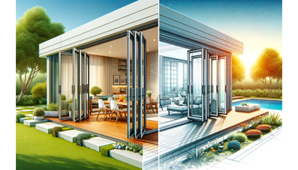Bi-folding vs. Sliding Doors
Bi-Folding vs. Sliding Doors: A Detailed Comparison for Modern Homes
Table of Contents
Bi-folding and sliding doors have become increasingly popular in modern home design, offering not just practicality but also adding a touch of elegance and openness to living spaces. These doors can transform a home, seamlessly blending indoor and outdoor environments, but choosing between them can be challenging. This comprehensive comparison will guide you through the key aspects of bi-folding and sliding doors, helping you decide which is best suited to your home.

Design and Aesthetic Appeal
Visual Impact and Style
Bi-folding doors, with their concertina effect, offer a dramatic transformation of space, creating wide openings that truly bring the outdoors in. They come in a range of styles and finishes, from minimalist to more traditional, catering to various architectural tastes. Sliding doors, on the other hand, are the epitome of sleek, contemporary design. Their large glass panes and slim frames provide unobstructed views and allow for abundant natural light, creating the illusion of a larger, more open space.
Customisation and Finishes
Both door types offer a high degree of customisation. Bi-folding doors can be tailored in terms of fold configurations and opening directions, while sliding doors can vary in the number of panels and their sliding mechanisms. The choice of finishes, from aluminium to UPVC and timber, along with a wide range of colours, ensures that both types of doors can complement the aesthetic of any home.
Space utilisation and Layout Considerations
Opening Size and Space Allocation
Bi-folding doors require some space to fold and stack when opened, which is an important consideration for smaller rooms or patios. However, when fully opened, they provide a complete opening that can seamlessly integrate indoor and outdoor spaces. Sliding doors, in contrast, offer a more compact solution as they operate within their own plane. This makes them ideal for rooms with limited space. However, they can only open as far as the panels can slide, usually leaving at least one pane width as a fixed panel.
Traffic Flow and Accessibility
In terms of traffic flow, bi-folding doors are highly versatile, with options for a traffic door that allows easy access without having to open the entire door. Sliding doors are simpler in operation, allowing easy passage through the sliding pane, but they can limit access when partially open due to the fixed pane.
Durability and Maintenance Requirements
Longevity and Material Considerations
The durability of both bi-folding and sliding doors largely depends on the quality of materials and construction. Aluminium frames are popular for their strength, durability, and low maintenance, while UPVC and timber options have their own advantages and aesthetic appeals.
Upkeep and Care
Bi-folding doors, with more moving parts and mechanisms, typically require more regular maintenance to ensure smooth operation. This includes periodic checks of hinges, tracks, and locks. Sliding doors, with fewer components, generally demand less maintenance. However, keeping the track clean and free from debris is essential to preventing any operational issues. For both types of doors, regular cleaning of the glass and frame is necessary to maintain their appearance and function. This includes wiping down the frames with a suitable cleaner and keeping the glass clear and streak-free. Choosing between bi-folding and sliding doors involves considering various factors, such as design preferences, space constraints, and maintenance requirements. Each type offers unique benefits and can significantly enhance the way you interact with your living space.
Energy Efficiency and Insulation
Thermal Performance and Glazing Options
One of the key considerations in choosing between bi-folding and sliding doors is energy efficiency, which is particularly important in maintaining comfortable temperatures and reducing energy bills. Both door types can be equipped with energy-efficient glazing options. Double or triple-glazed panels filled with inert gas, like Argon, significantly enhance insulation.
Sealing and Air Tightness
Bi-folding doors need to have high-quality seals to prevent air leakage, especially since they have multiple panels and junctions. Similarly, sliding doors require effective sealing around the frame and where the panels overlap to ensure there’s minimal air infiltration. Properly installed, both types can provide excellent insulation and contribute to a home’s overall energy efficiency.
Installation Process and Cost Implications
Understanding the Installation Complexity
The installation process can vary greatly between bi-folding and sliding doors. Bi-folding doors, with their multiple panels and complex mechanisms, generally require more intricate installation, potentially increasing labour costs. Sliding doors, while still needing precision in fitting, tend to be less complex in their installation.
Cost Comparison and Property Value Impact
In terms of cost, bi-folding doors can be more expensive than sliding doors, considering their complex mechanisms and installation requirements. However, the investment may increase property value, offering aesthetic appeal and improved functionality. It’s essential to weigh initial costs against long-term value and benefits.
Security Features and Safety Considerations
Advanced Locking Systems
Security is a paramount consideration for any external door. Modern bi-folding and sliding doors come equipped with advanced locking systems. Bi-folding doors often feature multi-point locking systems on each panel, while sliding doors can be fitted with robust, tamper-proof locks.
Safety Features
Safety features are equally important. Sliding doors should have anti-lift devices to prevent them from being removed from the outside. Similarly, bi-folding doors should have strong, secure hinges and robust tracks that can withstand forced entry. Additionally, considering the use of toughened or laminated glass can provide an extra layer of security and safety.
In summary, both bi-folding and sliding doors have their own unique benefits and drawbacks. Bi-folding doors offer dramatic design and full opening capabilities but require more space and maintenance. Sliding doors provide sleek elegance and space-saving qualities, with potentially lower maintenance needs. Both can be energy-efficient, secure, and add significant value to a property. Ultimately, the choice between bi-folding and sliding doors will depend on individual preferences, space considerations, and the specific needs of your home. When choosing between bi-folding and sliding doors for your home, it’s important to consider factors such as design preferences, space availability, energy efficiency, installation complexity, cost, and security. Bi-folding doors offer expansive openings and dramatic design impact but require more space and maintenance, while sliding doors provide a sleek, space-efficient solution with potentially lower upkeep.





